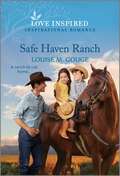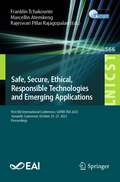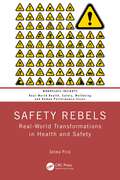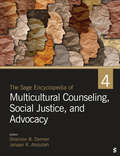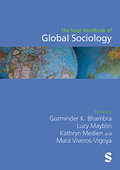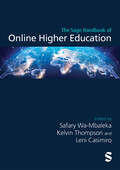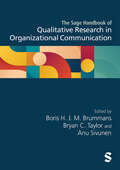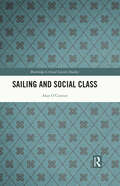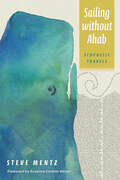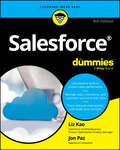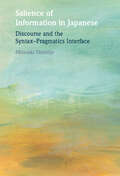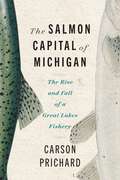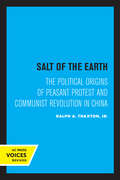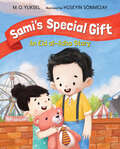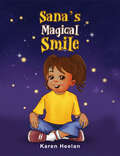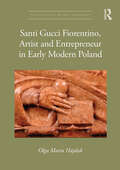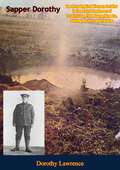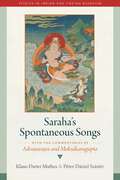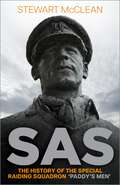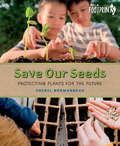- Table View
- List View
Safe Haven Ranch: An Uplifting Inspirational Romance
by Louise M. GougeCan two little children Help turn a feud into a family? It should be easy for widow Olivia Ortiz to despise Will Mattson, the man keeping her from buying the ranchland she needs for herself and her daughter, Emily. But when Emily becomes instant friends with Will&’s nephew, Jemmy, Olivia and Will find themselves growing closer as well. And as Olivia&’s feelings for the handsome cowboy shift, competing for the property could be the start of something more…From Love Inspired: Uplifting stories of faith, forgiveness and hope.
Safe, Secure, Ethical, Responsible Technologies and Emerging Applications: First EAI International Conference, SAFER-TEA 2023, Yaoundé, Cameroon, October 25-27, 2023, Proceedings (Lecture Notes of the Institute for Computer Sciences, Social Informatics and Telecommunications Engineering #566)
by Franklin Tchakounte Marcellin Atemkeng Rajeswari Pillai RajagopalanThis book constitutes the refereed proceedings of the First EAI International Conference on Safe, Secure, Ethical, Responsible Technologies and Emerging Applications, SAFER-TEA 2023, held in Yaoundé, Cameroon, during October 25-27, 2023. The 24 full papers were carefully reviewed and selected from 75 submissions. They were organized in topical sections as follows: Regulations and Ethics of Artificial Intelligence, Resource-constrained Networks and Cybersecurity, Emerging Artificial Intelligence Applications, Reviews.
Safety Rebels: Real-World Transformations in Health and Safety (Workplace Insights)
by Selma PirićSafety Rebels: Real-World Transformations in Health and Safety discusses the pragmatic experiences of over 30 safety professionals worldwide who managed to positively transform safety within their organizations. This book details the approaches taken while considering the politics and dynamics within each organization, including resistance to change, deteriorating safety statistics, increased number of procedures for operational personnel, high turnover, and budget restrictions.Professionals from the world of aerospace, healthcare, energy, oil, rail, and public services share their experiences of positive safety change, revealing transformations in different contexts. This book explains key safety principles, theories, and shared models. It reveals how the professionals applied state-of-the-art knowledge, Safety-II, FRAM, incident data, and artificial intelligence into their organization to prevent personnel from working in a silo. It includes relevant safety and multidisciplinary theories, from Heinrich’s incident model to resilience engineering, as well as aspects of change management and human organizational performance (HOP). These theories offer the reader a framework to try something new, and this book will inspire them to try contemporary strategies and tactics to approach safety challenges within any organization.This timely and easy-to-read book will appeal to professionals in the field of health and safety. It will have particular appeal to those working in Industrial Engineering, Aerospace Engineering, Nuclear Engineering, Mechanical Engineering, Civil Engineering, Chemical Engineering, Biomedical Engineering, and Electrical Engineering.
The Sage Encyclopedia of Multicultural Counseling, Social Justice, and Advocacy
by Shannon B. Dermer Jahaan R. AbdullahSince the late 1970s, there has been an increase in the study of diversity, inclusion, race, and ethnicity within the field of counseling. The SAGE Encyclopedia of Multicultural Counseling, Social Justice, and Advocacy will comprehensively synthesize a wide range of terms, concepts, ideologies, groups, and organizations through a diverse lens. This encyclopedia will include entries on a wide range of topics relative to multicultural counseling, social justice and advocacy, and the experiences of diverse groups. The encyclopedia will consist of approximately 600 signed entries, arranged alphabetically within four volumes.
The Sage Encyclopedia of Multicultural Counseling, Social Justice, and Advocacy
by Shannon B. Dermer Jahaan R. AbdullahSince the late 1970s, there has been an increase in the study of diversity, inclusion, race, and ethnicity within the field of counseling. The SAGE Encyclopedia of Multicultural Counseling, Social Justice, and Advocacy will comprehensively synthesize a wide range of terms, concepts, ideologies, groups, and organizations through a diverse lens. This encyclopedia will include entries on a wide range of topics relative to multicultural counseling, social justice and advocacy, and the experiences of diverse groups. The encyclopedia will consist of approximately 600 signed entries, arranged alphabetically within four volumes.
The Sage Handbook of Global Sociology
by Gurminder K. Bhambra Lucy Mayblin Kathryn Medien Mara Viveros-VigoyaThe SAGE Handbook of Global Sociology addresses the ‘social’, its various expressions globally, and the ways in which such understandings enable us to understand and account for global structures and processes. It demonstrates the vitality of thought from around the world by connecting theories and traditions, including reflections on European colonization, to build shared, rather than universal, understandings. Across 36 chapters, the Handbook offers a series of perspectives and cases from different locations, enabling the reader better to understand the particularities of specific contexts and how they are connected to global movements and structures. By moving beyond standard accounts of sociology and social theory, this Handbook offers both valuable insight into and scholarly contribution to the field of global sociology. Part 1: Politics Part 2: Labour Part 3: Kinship Part 4: Belief Part 5: Technology Part 6: Ecology
The Sage Handbook of Global Sociology
by Gurminder K. Bhambra Lucy Mayblin Kathryn Medien Mara Viveros-VigoyaThe SAGE Handbook of Global Sociology addresses the ‘social’, its various expressions globally, and the ways in which such understandings enable us to understand and account for global structures and processes. It demonstrates the vitality of thought from around the world by connecting theories and traditions, including reflections on European colonization, to build shared, rather than universal, understandings. Across 36 chapters, the Handbook offers a series of perspectives and cases from different locations, enabling the reader better to understand the particularities of specific contexts and how they are connected to global movements and structures. By moving beyond standard accounts of sociology and social theory, this Handbook offers both valuable insight into and scholarly contribution to the field of global sociology. Part 1: Politics Part 2: Labour Part 3: Kinship Part 4: Belief Part 5: Technology Part 6: Ecology
The Sage Handbook of Online Higher Education
by Safary Wa-Mbaleka Kelvin Thompson Leni CasimiroThe SAGE Handbook of Online Higher Education presents a cutting-edge collection of 50 essays that explores the rapidly evolving landscape of online teaching and learning in higher education. Assembled and contributed by a team of leading experts, the Handbook adopts a uniquely holistic approach to examining the needs of online education. Chapters bring together voices from diverse and international backgrounds to provide insights applicable to a broad range of contexts, and present practical strategies for planning, delivering quality online higher education. The handbook covers a wide range of topics, including online pedagogy, instructional design, student engagement, technological innovation, assessment, leadership, and the developing role of online education in the context of broader societal and cultural shifts. The SAGE Handbook of Online Higher Education is an essential resource for educators, researchers, policymakers, and practitioners who seek to understand and shape the future of higher education in the digital age. Section 1: Fundamentals of Online Education Section 2: Online Education Around the World Section 3: Online Instructional Design Section 4: Online Instructional Delivery Section 5: Instructional Technology for Online Education Section 6: Online Education Administration and Management Section 7: Student Support Services
The Sage Handbook of Online Higher Education
by Safary Wa-Mbaleka Kelvin Thompson Leni CasimiroThe SAGE Handbook of Online Higher Education presents a cutting-edge collection of 50 essays that explores the rapidly evolving landscape of online teaching and learning in higher education. Assembled and contributed by a team of leading experts, the Handbook adopts a uniquely holistic approach to examining the needs of online education. Chapters bring together voices from diverse and international backgrounds to provide insights applicable to a broad range of contexts, and present practical strategies for planning, delivering quality online higher education. The handbook covers a wide range of topics, including online pedagogy, instructional design, student engagement, technological innovation, assessment, leadership, and the developing role of online education in the context of broader societal and cultural shifts. The SAGE Handbook of Online Higher Education is an essential resource for educators, researchers, policymakers, and practitioners who seek to understand and shape the future of higher education in the digital age. Section 1: Fundamentals of Online Education Section 2: Online Education Around the World Section 3: Online Instructional Design Section 4: Online Instructional Delivery Section 5: Instructional Technology for Online Education Section 6: Online Education Administration and Management Section 7: Student Support Services
The Sage Handbook of Qualitative Research in Organizational Communication
by Boris H. J. M. Brummans Bryan C. Taylor Anu SivunenThe Sage Handbook of Qualitative Research in Organizational Communication is a state-of-the-art resource for scholars, students, and practitioners seeking to deepen their understanding and expertise in this dynamic field. Written by a global team of established and emerging experts, this Handbook provides a comprehensive exploration of the field’s foundational traditions of epistemology and theory, as well as its latest methodologies, methods, issues, and debates. The volume reflects a diverse range of approaches (e.g., mixed-methods, ethnographic, rhetorical, pragmatist, phenomenological, feminist, critical race, postcolonial, queer, and engaged), and covers a broad spectrum of topics ranging from data collection and analysis, to representation. Additionally, this Handbook addresses emerging trends such as digital forensics, post-qualitative research, and the transformative impact of COVID-19 on the conduct of qualitative research in organizational communication. As the first volume of its kind in this field, The Sage Handbook of Qualitative Research in Organizational Communication is a cornerstone text for scholars, students, and practitioners interested in understanding the vital role of communication in organizational life. Part 1: Approaches to Qualitative Organizational Communication Research Part 2: Data Collection in Qualitative Organizational Communication Research: Methods and Issues Part 3: Data Analysis and Representation in Qualitative Organizational Communication Research: Methods and Issues Part 4: The Future of Qualitative Organizational Communication Research
The Sage Handbook of Qualitative Research in Organizational Communication
by Boris H. J. M. Brummans Bryan C. Taylor Anu SivunenThe Sage Handbook of Qualitative Research in Organizational Communication is a state-of-the-art resource for scholars, students, and practitioners seeking to deepen their understanding and expertise in this dynamic field. Written by a global team of established and emerging experts, this Handbook provides a comprehensive exploration of the field’s foundational traditions of epistemology and theory, as well as its latest methodologies, methods, issues, and debates. The volume reflects a diverse range of approaches (e.g., mixed-methods, ethnographic, rhetorical, pragmatist, phenomenological, feminist, critical race, postcolonial, queer, and engaged), and covers a broad spectrum of topics ranging from data collection and analysis, to representation. Additionally, this Handbook addresses emerging trends such as digital forensics, post-qualitative research, and the transformative impact of COVID-19 on the conduct of qualitative research in organizational communication. As the first volume of its kind in this field, The Sage Handbook of Qualitative Research in Organizational Communication is a cornerstone text for scholars, students, and practitioners interested in understanding the vital role of communication in organizational life. Part 1: Approaches to Qualitative Organizational Communication Research Part 2: Data Collection in Qualitative Organizational Communication Research: Methods and Issues Part 3: Data Analysis and Representation in Qualitative Organizational Communication Research: Methods and Issues Part 4: The Future of Qualitative Organizational Communication Research
Sailing and Social Class (Routledge Critical Leisure Studies)
by Alan O'ConnorThis book explores the sociology of sailing and yachting. Drawing on original research, and employing a theoretical framework based on the work of Pierre Bourdieu, the book argues that sailing is, still, an upper-middle-class activity that has much to tell us about the wider sociology of leisure and sport. The book examines the historical foundations of blue-water sailing as established by naval and colonial shipping, to trace the roots of contemporary sailing and yachting culture. It also examines archives of sailing narratives and cruising guides, as well as the children’s books of Arthur Ransome, arguing that this archival material offers a social rather than a psychological interpretation of the ‘bodily investment’ in sailing. The book uses Bourdieu’s concepts of ‘illusio’ – an investment of time, emotion and body into a worthwhile activity – and ‘habitus’, or lifeworld, alongside contemporary data sets, to examine the yacht club as a social institution, including why many boats never go out on the water, the relationship between yacht clubs and the state, and social issues as manifested in yacht clubs, such as sexism, racism and homophobia. Offering a vigorous sociological critique of yachting and sailing, this book is fascinating reading for anybody with an interest in the sociology of leisure and sport, subcultures, social theory, or social issues in wider society.
Sailing without Ahab: Ecopoetic Travels
by Steve MentzJourney through uncharted literary waters and explore Melville’s epic in bold new lightCome sail with I.We’re not taking the same trip, though you might recognize the familiar course. This time, the Pequod’s American voyage steers its course across the curvature of the Word Ocean without anyone at the helm. We are leaving one man and his madness on shore. Our ship overflows with glorious plurality—multiracial, visionary, queer, conflicted, polyphonic, playful, violent. But on this voyage something is different. Today we sail headless without any Captain. Instead of binding ourselves to the dismasted tyrant’s rage, the ship’s crew seeks only what we will find: currents teeming with life, a blue-watered alien globe, toothy cetacean smiles from vasty deeps. Treasures await those who sail without.This cycle of one hundred thirty-eight poems—one for each chapter in Moby-Dick, plus the Etymology, Extracts, and Epilogue—launches into oceanic chaos without the stabilizing mad focus of the Nantucket captain. Guided by waywardness and curiosity, these poems seek an alien ecopoetics of marine depths, the refraction of light, the taste of salt on skin. Directionless, these poems reach out to touch oceanic expanse and depth. It’s not an easy voyage, and not a certain one. It lures you forward. It has fixed its barbed hook in I.Sailing without means relinquishing goals, sleeping at the masthead, forgetting obsessions. I welcome you to trace wayward ways through these poems. Read them any way you can—back to front, at random, sideways, following the obscure promptings of your heart. It’s the turning that matters. It’s a blue wonder world that beckons.
Salesforce For Dummies
by Liz Kao Jon PazYour easy-to-follow guide to the world’s leading cloud-based CRM software Salesforce gives your business an edge in tracking relationships and managing sales, marketing, customer service, and support operations. Salesforce For Dummies help you take advantage of key platform functionality and focus on making the most of its many features. Learn best practices to determine the right configuration to suit your business needs, and how to use apps, build widgets, and configure features to personalize your system for your business. Explore prospecting for leads, managing accounts, maintaining contacts, tracking products, calculating forecasts, and monitoring each customer’s service and support interactions with your business. Collaborate with colleagues by sharing information across a 360-degree view of all customer interactions, enhance your online marketing, gain real-time visibility into sales, and close deals faster. Get started with configuring Salesforce and set up the apps that your business needs Discover the latest updates to Salesforce, including Flow Builder, Lightning, and Einstein Improve business performance with reporting insights, collaborative communication features, and integrated sales and marketing processes Find new ways to improve productivity and reduce administration timeSalesforce For Dummies is the fully updated, best-selling guide that helps new and existing users get up to speed with the world’s top CRM.
Salience of Information in Japanese: Discourse and the Syntax–Pragmatics Interface
by null Mitsuaki Shimojo'Salience' is a linguistic phenomenon whereby information that is 'given', or 'new', is distributed and presented within a sentence in particular ways that convey its relevance. Although it has been widely described as the speaker's linguistic choices based on the hearer's perspective, it has received less attention as the speaker's manipulations of the hearer's cognitive states. This timely study redresses that balance by analysing several morphosyntactic phenomena in Japanese, drawing on a wide range of authentic language examples. Taking a functionalist perspective, it brings together studies of grammar and discourse, which are often described separately, and deploys the combined grammar-discourse approach in Role and Reference Grammar, the structural-functionalist theory in which syntax, semantics, and pragmatics are equally central to our understanding of language. It also offers an analysis of second language (L2) learners' Japanese discourse, and demonstrates the relevance of that analysis to issues outside of traditional second language research.
The Salmon Capital of Michigan: The Rise and Fall of a Great Lakes Fishery (Great Lakes Books Series)
by Carson PrichardWeaving together the stories and voices of residents, anglers, community leaders, and environmental workers and researchers, this ethnographic account details the lives and livelihoods impacted by a once-unrivaled Michigan salmon fishery. From the introduction of Chinook salmon to the Great Lakes in the late 1960s, a thriving recreational fishery industry arose in Northern Michigan, attracting thousands of anglers to small towns like Rogers City each week at its peak. By the early 2000s, a crisis loomed beneath the surface of Lake Huron as the population of a prey fish species called alewife unexpectedly collapsed, depleting the salmon’s main source of food. By 2007, the salmon population had collapsed too, leaving local fisheries and their respective communities lacking a key commodity and a bid on fishery tourism. Author, angler, and ecologist Carson Prichard artfully incorporates fisheries science and local news media into an oral history that is entertaining, rich, and genuine. Complementing an ecological understanding of events, this narrative details the significance of the fishery and its loss as experienced by the townspeople whose lives it touched.
Salt of the Earth: The Political Origins of Peasant Protest and Communist Revolution in China
by Ralph A. Thaxton Jr.On October 1, 1949, a rural-based insurgency demolished the Nationalist government of Chiang-kai Shek and brought the Chinese Communists to national power. How did the Chinese Communists gain their mandate to rule the countryside? In this pathbreaking study, Ralph A. Thaxton, Jr., provides a fresh and strikingly original interpretation of the political and economic origins of the October revolution. Salt of the Earth is based on direct interviews with the village people whose individual and collective protest activities helped shape the nature and course of the Chinese revolution in the deep countryside. Focusing on the Party's relationship with locally esteemed non-Communist leaders, the author shows that the Party's role is best understood in terms of its intimate connections with local collective activism and with existing modes of local protest, both of which were the product of rural people acting on their own grievances, interests, and goals. The author's collection and use of oral histories—from the last remaining eyewitnesses—and written corroborative materials is a remarkable achievement; his new interpretation of why China's rural people supported and joined the Communists in their quest for state power is dramatically different from what has come before. This book will stimulate debates on the genesis of popular mobilization and the growth of insurgency for decades to come. This title is part of UC Press's Voices Revived program, which commemorates University of California Press's mission to seek out and cultivate the brightest minds and give them voice, reach, and impact. Drawing on a backlist dating to 1893, Voices Revived makes high-quality, peer-reviewed scholarship accessible once again using print-on-demand technology. This title was originally published in 1997.
Sami's Special Gift: An Eid al-Adha Story
by M. O. YukselIt&’s Eid al-Adha, and Sami wants to celebrate. But this year is different after his grandfather&’s passing. A touching picture book about kindness towards others.Sami worries that the Eid al-Adha carnival won&’t be as fun without Dede (his grandfather), who died recently. Sami&’s grandmother sends him one of Dede&’s ties, and Sami vows to never take it off. After going to the mosque for Eid prayer, Sami&’s family stop at the shelter where Baba and Anne volunteer. Can an unexpected encounter and a special gift help Sami change his mind about celebrating? The gift of giving and putting yourself in someone else's shoes shines through in this engaging, poignant holiday story.
Sana's Magical Smile
by Karen HeelanSana is happy and excited when she wakes up because she’s been planning this fun day for ages. Little does she know that her day is about to get better and better when she discovers her smile has amazing magical powers! Follow along on her wonderful day in Sana’s Magical Smile.
Sand Filly: Book 6 (Moonlight Riders #6)
by Linda ChapmanHarness the power of the elements with the Moonlight Riders! An exciting series for young readers from bestselling author Linda Chapman, author of MY SECRET UNICORN and UNICORN ACADEMY.Could you be a True Rider?The Moonlight Stables friends are heading to the seaside for a week long pony training camp - and Willow's coming too! Unfortunately, the Storm Stables riders aren't far behind and they're determined to ruin the week for Willow and Amara after they bested them at summer camp.To make matters worse, Bea's dad wants to move her to Storm Stables. The friends have to find a way to convince him to let her stay. Can a new Storm Stables ally help them and will Sandy finally choose Bea to be her True Rider?Don't miss the other Moonlight Riders stories!Fire HorseStorm StallionPetal PonySea FoalSnow Mare
Santi Gucci Fiorentino, Artist and Entrepreneur in Early Modern Poland (ISSN)
by Olga Maria HajdukThe original research in this book analyzes the artistic activity of Santi Gucci (1533– c.1600), a Florentine sculptor active in Poland in the second half of the sixteenth century, and his workshop.Chapters examine the organization of the artistic workshop (sculpting and masonry) and the model of the artist’s functioning as an entrepreneur in Renaissance Poland, using Santi Gucci’s activity as an example. Gucci shaped the image of Polish sculpture in the sixteenth century for more than 50 years, even though his work has not yet been fully examined. The author sets Gucci’s emigration within the context of the cultural exchanges between Italy and Poland that contributed to the development of the Polish Renaissance.The book will be of interest to scholars working in art history, Renaissance studies, architectural history and economic history.
Sapper Dorothy: 51st Division, 79th Tunnelling Co. During the First World War
by Dorothy LawrenceThe adventures of an intrepid young woman on the Western FrontIt would not be quite accurate to portray Dorothy Lawrence as a bona fide soldier of the British Army. Dorothy was in fact a young woman with great aspirations to embark upon a career in journalism and she knew it would be a coup to give a female perspective of the activities of men on the front line-as it were-from within their own ranks. So she devised a scheme to bring her objectives about and its success was marked by a 10 day stint in the line at Albert in 1915 with the Royal Engineers during the opening stages of the battle of Loos. Dorothy certainly saw action—the trench she occupied lay less than 400 yards from the German front line. She was eventually discovered and the entire story of how she pulled off her subterfuge, her time in the trenches and what befell her thereafter is told in this delightful account.-Print ed.
Saraha's Spontaneous Songs: With the Commentaries by Advayavajra and Moksakaragupta
by Klaus-Dieter Mathes Péter-Dániel SzántóThe first volume in over six decades to bring to light new original material on Saraha&’s Treasury of Spontaneous Songs (Dohakosa).&“Completely abandon thought and no-thought, and abide in the natural way of a small child.&” —Saraha To find liberation and realize the true nature of reality, the Indian Buddhist master Saraha says we must leave behind any conceptual assessment of reality, since no model of it has ever been known to withstand critical analysis. Saraha&’s spontaneous songs, or dohas, represent the Buddhist art of expressing the inexpressible. The most important collection of Saraha&’s songs is the Dohakosagiti, better known in Tibet as the Songs for the People, and the Tibetan Mahamudra tradition, especially within the Kagyü school, has done the most to preserve the lineage of Saraha&’s instructions to the present day. But Saraha was also widely cited in Indian sources starting around the eleventh century, and one Indic commentary, by the Newar scholar Advayavajra, still exists in Sanskrit. In addition, we have independent root texts of Saraha&’s songs in the vernacular Apabhramsa in which they were recorded. These Indian texts, together with their Tibetan translations, are here presented in masterful new critical editions along with the Tibetan translation of the commentary no longer extant in Sanskrit by Moksakaragupta. Finally, both commentaries are rendered in elegant English, and the authors offer a brisk, comprehensive introduction. Saraha&’s Spontaneous Songs provides the reader with everything needed for a serious study of one of the most important works in the Indian Buddhist canon.
SAS: The History of the Special Raiding Squadron 'Paddy's Men'
by Stewart McCleanAn illustrated history of the SAS
Save Our Seeds: Protecting Plants for the Future (Orca Footprints #31)
by Sheryl NormandeauKey Selling Points Learning about the importance of seeds and how to save and conserve them for the future is imperative to sustaining healthy life on the planet. Introduces young readers to STEM concepts, such as pollination, biodiversity, healthy ecosystems, food security, the climate crisis, GMO food and genetic engineering. Gives young readers the practical tools to take action to save seeds in their own lives and communities. The author is a certified master gardener and works with various gardening organizations in Alberta. She has a background in horticulture and urban agriculture and has written a number of nonfiction books for adults and kids.
